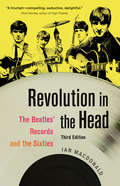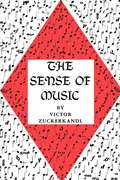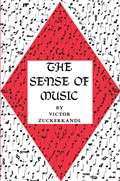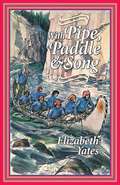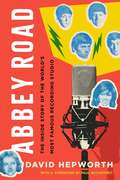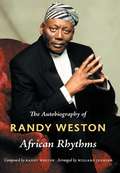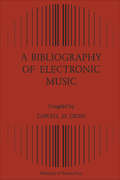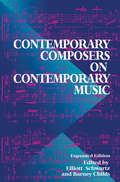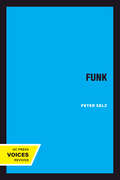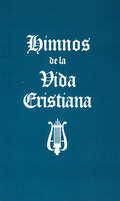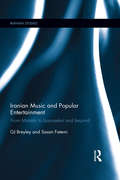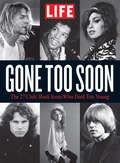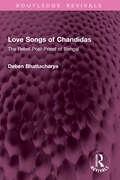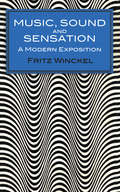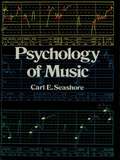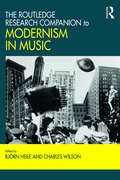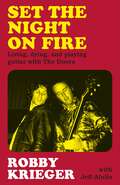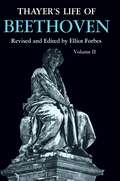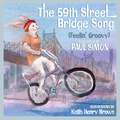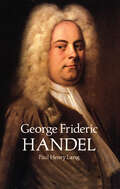- Table View
- List View
Revolution in the Head: The Beatles' Records and the Sixties
by Ian MacdonaldThis "Bible of the Beatles" captures the iconic band's magical and mysterious journey from adorable teenagers to revered cultural emissaries. In this fully updated version, each of their 241 tracks is assessed chronologically from their first amateur recordings in 1957 to their final "reunion" recording in 1995. It also incorporates new information from the Anthology series and recent interviews with Paul McCartney. This comprehensive guide offers fascinating details about the Beatles' lives, music, and era, never losing sight of what made the band so important, unique, and enjoyable.
The Sense of Music
by Victor ZuckerkandlThis book is addressed to the listener whose enjoyment of music is filled with questions and whose curiosity makes him eager to grasp the sense of music, despite a lack of theoretical training. Unlike the usual listener's guide, which begins with a discussion of the elementary materials of music, this book starts with the elementary experiences of listening.
The Sense of Music
by Victor ZuckerkandlThis book is addressed to the listener whose enjoyment of music is filled with questions and whose curiosity makes him eager to grasp the sense of music, despite a lack of theoretical training. Unlike the usual listener's guide, which begins with a discussion of the elementary materials of music, this book starts with the elementary experiences of listening.
Spanian: The Unfiltered Hood Life
by SpanianBy the time he was twelve, Spanian knew he would follow his family's footsteps to become a career criminal. What followed was a decade-long string of brazen crimes and brutal violence: stabbings, ram-raids, drug runs and a notorious high school siege. Throughout the Sydney social housing enclaves of Redfern, Waterloo and Woolloomooloo, Spanian earned a reputation as one of the city's most flagrant crooks; armed with a boxcutter in one hand, and a syringe in the other.But it all came at a damning price: in the throes of heroin addiction and thirteen years wasted behind bars, Spanian became a longstanding resident of jails across New South Wales. There, he was embroiled in racial divisions, prison politics, and a vicious vortex of self-destruction, until music and books became an unlikely lifeline. Reading and rapping became new rituals, and a glistening light at the end of the tunnel. Released from Bathurst Correctional Centre in 2017 with newfound purpose, Spanian has since found viral fame and a sprawling, worldwide audience through hip-hop and his magnetic social media presence.This is the powerful, unflinching and high-octane memoir of how a young inner-city kid became Spanian. It gives unapologetic insight into the gritty socio-economic underbelly of Sydney city, the criminal justice system, and the correctional system. The story of Spanian provides hope that even the most stubborn cycles can be broken, and new dreams made.
With Pipe, Paddle and Song: A Story of the French-Canadian Voyageurs
by Elizabeth YatesSon of a French nobleman and a Chippewa Indian woman, Guillaume has spent half of his life in his father's Montréal château, half in his mother's village. When his father returns to France, the 16-year-old is determined to make his own way in the world. He signs up with a rough and ready crew of voyageurs, who yearly make their journey into the wilds of Canada to bring back the rich furs that have made New France prosperous. Newbery award winner Elizabeth Yates skillfully weaves history and the theme of a young man coming to grips with two worlds' conflicting demands. Included in the book is an extensive collection of voyageur songs, with music and lyrics.
Abbey Road: The Inside Story of the World's Most Famous Recording Studio
by David HepworthThe incredible history of how Abbey Road became the most famous recording studio in the world. "There are certain things that are mythical. Abbey Road is mythical."—Nile Rodgers Many people will recognize the famous crosswalk. Some visitors may have graffitied their name on its hallowed outer walls. Others might even have managed to penetrate the iron gates. But what draws in these thousands of fans here, year after year? What is it that really happens behind the doors of the most celebrated recording studio in the world? It may have begun life as an affluent suburban house, but it soon became a creative hub renowned around the world as a place where great music, ground-breaking sounds, and unforgettable tunes were forged. It is nothing less than a witness to, and a key participant in, the history of popular music itself. What has been going on there for over ninety years has called for skills that are musical, creative, technical, mechanical, interpersonal, logistical, managerial, chemical and, romantics might be tempted add, close to magic. The history of Abbey Road may just make you believe.
African Rhythms: The Autobiography of Randy Weston
by Randy WestonThe pianist, composer, and bandleader Randy Weston is one of the world's most influential jazz musicians and a remarkable storyteller whose career has spanned five continents and more than six decades. Packed with fascinating anecdotes, African Rhythms is Weston's life story, as told by him to the music journalist Willard Jenkins. It encompasses Weston's childhood in Brooklyn's Bedford-Stuyvesant neighborhood--where his parents and other members of their generation imbued him with pride in his African heritage--and his introduction to jazz and early years as a musician in the artistic ferment of mid-twentieth-century New York. His music has taken him around the world: he has performed in eighteen African countries, in Buddhist temples and Shinto shrines, in the Canterbury Cathedral, and at the grand opening of the Bibliotheca Alexandrina: The New Library of Alexandria. Africa is at the core of Weston's music and spirituality. He has traversed the continent on a continuous quest to learn about its musical traditions, produced its first major jazz festival, and lived for years in Morocco, where he opened a popular jazz club, the African Rhythms Club, in Tangier. Weston's narrative is replete with tales of the people he has met and befriended, and with whom he has worked. He describes his unique partnerships with Langston Hughes, the musician and arranger Melba Liston, and the jazz scholar Marshall Stearns, as well as his friendships and collaborations with Duke Ellington, Dizzy Gillespie, Coleman Hawkins, Thelonious Monk, Billy Strayhorn, Max Roach, Charlie Parker, Miles Davis, the novelist Paul Bowles, the Cuban percussionist Candido Camero, the Ghanaian jazz artist Kofi Ghanaba, the Gnawa musicians of Morocco, and many others. With African Rhythms, an international jazz virtuoso continues to create cultural history.
A Bibliography of Electronic Music
by Lowell CrossThis exhaustive bibliography, reflecting current interest in electronic music, includes all available citations of books, articles, and monographs pertaining to "musique concrète," "Elektronische Musik," "tape music," and "computer music" from publications in fourteen languages. Organized alphabetically by author, or, in the case of unsigned works, by title, and including a classified subject index, this book will appeal primarily to persons or organizations who are founding or maintaining electronic music centres, composing or performing electronic music, or pursuing original research in experimental music and related disciplines.
Chaliapin An Autobiography as told to Maxim Gorky
by Nina Froud James HanleyFeodor Ivanovich Chaliapin (1873-1938) was a Russian bass who was famous for his singing and his acting in opera. This book covers is life to 1915 and primarily consists of his reminiscences of childhood and early singing career as told to Maxim Gorky. The last third of the book contains correspondence and early appraisals of his singing and a list of early performances.
Contemporary Composers on Contemporary Music
by Elliott Schwartz Barney ChildsThis anthology of essays, interviews, and autobiographical pieces provides an invaluable overview of the evolution of contemporary music-from chromaticism, serialism, and indeterminacy to jazz, vernacular, electronic, and non-Western influences. Featuring classic essays by Stravinsky, Stockhausen, and Reich, as well as writings by lesser-known but equally innovative composers such as Jack Beeson, Richard Maxfield, and T. J. Anderson, this collection covers a broad range of styles and approaches. Here you will find Busoni's influential "Sketch of a New Esthetic of Music"; Partch's exploration of a new notation system; Babbitt's defense of advanced composition in his controversial "Who Cares If You Listen?"; and Pauline Oliveros's meditations on sound. Now updated with fifteen new composers including Michael Tippet, György Ligeti, Gunther Schuller, Ben Johnston, Sofia Gubaidulina, and William Bolcom, this important book gathers together forty-nine pieces-many out of print and some newly written for this volume-which serve as a documentary history of twentieth-century music, in theory and practice. Impassioned, provocative, and eloquent, these writings are as exciting and diverse as the music they discuss.
Funk
by Peter SelzThis title is part of UC Press's Voices Revived program, which commemorates University of California Press’s mission to seek out and cultivate the brightest minds and give them voice, reach, and impact. Drawing on a backlist dating to 1893, Voices Revived makes high-quality, peer-reviewed scholarship accessible once again using print-on-demand technology. This title was originally published in 1967.This title is part of UC Press's Voices Revived program, which commemorates University of California Press’s mission to seek out and cultivate the brightest minds and give them voice, reach, and impact. Drawing on a backlist dating to 1893, Voices Revived</DIV
Himnos de la Vida Cristiana (palabras solamente): Una coleccion de antiguos y nuevos Himnos de Alabanza a Dios
by Moody PublishersEl libro Himnos de la Vida Cristiana (palabras solamente) es un edición electrónica asequible que contiene solamente las palabras de los 354 himnos que aparecen en la edición de música completa.
Himnos de la Vida Cristiana (palabras solamente): Una coleccion de antiguos y nuevos Himnos de Alabanza a Dios
by Moody PublishersEl libro Himnos de la Vida Cristiana (palabras solamente) es un edición electrónica asequible que contiene solamente las palabras de los 354 himnos que aparecen en la edición de música completa.
Iranian Music and Popular Entertainment: From Motrebi to Losanjelesi and Beyond (Iranian Studies)
by Sasan Fatemi Gj BreyleyThe word motreb finds its roots in the Arabic verb taraba, meaning 'to make happy.' Originally denoting all musicians in Iran, motrebi came to be associated, pejoratively, with the cheerful vulgarity of the lowbrow entertainer. In Iranian Music and Popular Entertainment, GJ Breyley and Sasan Fatemi examine the historically overlooked motrebi milieu, with its marginalized characters, from luti to gardan koloft and mashti, as well as the tenacity of motreb who continued their careers against all odds. They then turn to losanjelesi, the most pervasive form of Iranian popular music that developed as motrebi declined, and related musical forms in Iran and its diasporic popular cultural centre, Los Angeles. For the first time in English, the book makes available musical transcriptions, analysis and lyrics that illustrate the complexities of this history. As it presents the findings of the authors' years of ethnographic work with the history's protagonists, from senior motreb to pop-rock stars, the book reveals parallels between the decline of motrebi and the rise of 'modernity.' In the twentieth century, the fate of Tehran's motrebi music was shaped by the social and urban polarization that ensued from the modern market economy, and losanjelesi would be similarly affected by transnational relations, revolution, war and migration. Through its detailed and informed examination of Iranian popular music, this study reveals much about the values and anxieties of Iranian society, and is a valuable resource for students and scholars of Iranian society and history.
LIFE Gone Too Soon: The 27 Club - Rock Icons Who Died Too Soon
by The Editors of LifeThe story of the 27 club is a one of brilliance: precious, fragile, and amazing to behold. Six musical artists who all happened to die at the same early age-27-did more than perform memorable songs: They expressed ideas and emotions that were shared by enthralled followers from their generations and beyond. The stories of these luminous artist lead to tragic ends. But the lives they led were transformative-to music, to culture, and to countless lives.In Gone Too Soon: The 27 Club, LIFE pulls you into the brief and explosive lives of musicians Brian Jones, Jimi Hendrix, Janis Joplin, Jim Morrison, Kurt Cobain, and Amy Winehouse through photographs and interviews. Read how Hendrix uniquely mashed together blues and rock into a paisley-patterned kaleidoscope of sound, look at images of Cobain's infamous MTV Unplugged special and much more. The legacy of these artists still lives and breathes onstage, embodied by musicians who looked to these icons for inspiration.
Liszt
by Sacheverell SitwellBiography of the famous composer, a man of extraordinary magnetism and a pianist of unsurpassed virtuosity. Bibliography and a catalog of Liszt's works included.
Love Songs of Chandidas: The Rebel Poet-Priest of Bengal (Routledge Revivals)
by Deben BhattacharyaFirst published in 1967, Love Songs of Chandidās provides an informative introduction which makes vividly clear the importance of Chandidās to the Indian peasant masses. As the author tells us, the traveller through the Birbhum area of Bengal hears Chandidās everywhere, in the villages, in the fields, on the roads. Night after night, the people gather in the temple courtyards or on the village greens to listen to professional ‘Kirtan’ singers sing his songs of the divine love of Radha and Krishna. The influence of Chandidās on contemporary Bengali literature is equally important, his songs having enriched the work of great poets such as Rabindranath Tagore, Govindadas, and many others. The author also discusses the interesting topic of the Sahaja (‘spontaneity’) movement in Indian faith and literature, as manifested in the songs of Chandidās, and the worship of love-making, divine and human, as an important aspect of this faith. This book will be of interest to students of literature, music, history, cultural studies and South Asian studies.
**Missing**: A Children's Picture Book (LyricPop #0)
by Otis Redding Steve CropperIncluded in Publishers Weekly's Spring 2021 Children's Sneak Previews Otis Redding and Steve Cropper's timeless ode to never-ending days is given fresh new life in this heartwarming picture book. Sittin' in the mornin' sun I'll be sittin' when the evening comes Watching the ships roll in Then I'll watch 'em roll away again, yeah (Sittin' on) The Dock of the Bay is a charming picture book set to one of the King of Soul's™ greatest hits. The song was one of the last Redding recorded, and ranked number four on Billboard's year-end Hot 100 chart, going on to win two GRAMMYs and be certified triple-platinum. With lyrics by Otis Redding and Steve Cropper and illustrations by Kaitlyn Shea O'Connor, this picture book imagines a lonesome cat fishing off a dock and hoping the fish will bite soon. (Sittin' on) The Dock of the Bay is the perfect picture book for parents wanting to share a classic song with their children, allowing both to find joy in it along the way. The Otis Redding Foundation: Redding was dedicated to improving the quality of life for his community through the education and empowerment of its youth. He provided scholarships and summer music programs which continued until his untimely death on December 10, 1967. Today, the mission of the Otis Redding Foundation, established in 2007 by Mrs. Zelma Redding, is to empower, enrich, and motivate all young people through programs involving music, writing, and instrumentation. To learn more, visit: otisreddingfoundation.org
Music, Sound and Sensation: A Modern Exposition
by Fritz WinckelRelated closely to the field of physical acoustics is that of psychoacoustics, which deals with the phenomena of musical hearing from a psychological and aesthetic point of view. One of the major contributors to our understanding of the subject is Fritz Winckel. When this book first appeared in German in 1960, reviewers pressed for an English translation. This Dover volume is an answer to that demand: it makes Professor "Winckel's important study generally available to English-language readers for the very first time." It has been extensively revised and updated by the author.In his thought-provoking study, Professor Winckel applies the findings of technical researches in acoustics to the practice of music, covering many different aspects of recent psychoacoustical researches: the evaluation of loudness and the dissolution power of the car; the influence of the acoustical properties of the concert hall on the hearing process; the function of time variation and rhythm in musical perception; the evaluation of the sound spectrum including the unharmonic components. He surveys extensively the German and English literature in the field, organizing his information into chapters on stationary sound, the onset behavior of sound, the concept of space, the concept of time, the evaluation of sound through the hearing mechanism, unclarity in musical structures, simultaneously sounding tones, electroacoustic sound structure, and the effect of music on the listener.This book should prove equally useful to acousticians, sound engineers, and others working in this area of applied physics and to composers, performers, and musicologists concerned with the technical aspects of music. Psychologists working in the field of sense perception will also find much of value here.New translation by Thomas Binkley of the 1960 German edition of Phänomene des musikalischen Hörens, with revisions and corrections by the author.
Psychology of Music
by Carl E. SeashoreBetween the physical world of vibration, as measured by apparatus, and the world of consciously heard music there is a third area of investigation. Our auditory apparatus and/or mind separates different instruments and tones, hears some vibrations but not others, adds tones to fill out the sound spectrum, etc. This middle ground is the province of the psychology of music, a subject about which even many physical scientists know little.This introduction, by the developer of the Seashore test of musical ability, is a thorough survey of this field, the standard book for psychologists specializing in the area, for the school, and for interested musicologists. It opens with the musical mind and with a series of chapters on music as a medium: vibrato, pitch, loudness, duration, timbre, tone, consonance, volume, and rhythm, dealing with each from the special point of view of the role of psychology. It then moves to such factors as learning, imagining, and thinking in music; the nature of musical feeling; the relative sound patterns of specific instruments and the human voice; measures of musical talent; inheritance of musical ability; primitive music; the development of musical skills; and musical aesthetics.This wealth of material is supplemented with dozens of oscillograms and other sound-pattern charts recorded from actual play and singing by Jeritza, Caruso, Paderewski, Szigeti, Rethberg, Menuhin, Martinelli, and other artists. An appendix cites two attitudes toward the evaluation of musical talent and over 200 bibliographic references.
The Routledge Research Companion to Modernism in Music
by Björn Heile Charles WilsonModernism in music still arouses passions and is riven by controversies. Taking root in the early decades of the twentieth century, it achieved ideological dominance for almost three decades following the Second World War, before becoming the object of widespread critique in the last two decades of the century, both from critics and composers of a postmodern persuasion and from prominent scholars associated with the ‘new musicology’. Yet these critiques have failed to dampen its ongoing resilience. The picture of modernism has considerably broadened and diversified, and has remained a pivotal focus of debate well into the twenty-first century. This Research Companion does not seek to limit what musical modernism might be. At the same time, it resists any dilution of the term that would see its indiscriminate application to practically any and all music of a certain period. In addition to addressing issues already well established in modernist studies such as aesthetics, history, institutions, place, diaspora, cosmopolitanism, production and performance, communication technologies and the interface with postmodernism, this volume also explores topics that are less established; among them: modernism and affect, modernism and comedy, modernism versus the ‘contemporary’, and the crucial distinction between modernism in popular culture and a ‘popular modernism’, a modernism of the people. In doing so, this text seeks to define modernism in music by probing its margins as much as by restating its supposed essence.
Set the Night on Fire: Living, Dying and Playing Guitar with the Doors
by Robby KriegerFew bands are as shrouded in the murky haze of rock mythology as The Doors, and parsing fact from fiction has been a virtually impossible task. But now, after fifty years, The Doors' notoriously quiet guitarist is finally breaking his silence to set the record straight.Through a series of vignettes, Robby takes readers back to where it all happened: the pawn shop where he bought his first guitar; the jail cell he was tossed into after a teenage drug bust; his parents' living room where his first songwriting sessions with Jim Morrison took place; and the many concert venues that erupted into historic riots.Robby also goes into heartbreaking detail about his life's most difficult struggles, ranging from drug addiction to cancer, but he balances out the sorrow with humorous anecdotes about run-ins with unstable fans, famous musicians, and one really angry monk. SET THE NIGHT ON FIRE is at once an insightful time capsule of 1960s counterculture and a moving reflection on what it means to find oneself as a musician. It's not only a must-read for Doors fans, but an essential volume of American pop culture history.
Thayer's Life of Beethoven, Part II
by Elliot ForbesAlexander Wheelock Thayer's Life of Beethoven. has long been recognized as the classic biography of Beethoven. "Thayer, with his calm and logical mind, scrupulous, magnanimous and spacious...had set out to describe for posterity the great man as he was and lived...and his patient realism and all but inexhaustible industry had created an irreplaceable and masterly portrait." So Van Wyck Brooks described this monumental work of the 1880's.Thayer talked with Beethoven's surviving friends, gathered anecdotes, and sifted hundreds of documents. The resulting wealth of detail stimulated other students, and a mass of Beethoven scholarship appeared. Now Elliot Forbes, one of the foremost Beethoven scholars of our time, has used this new material to bring the Life up to elate without sacrificing Thayer's text.
The 59th Street Bridge Song: A Children's Picture Book (LyricPop #0)
by Keith Henry Brown Paul SimonPaul Simon's groovy anthem to New York City provides a joyful basis for this live-for-the-day picture book. "Slow down, you move too fast You got to make the mornin' last Just kicking down the cobblestones
George Frideric Handel (Dover Books On Music: Composers)
by Paul Henry Lang"I was so impressed by what Dr. Lang has done in his new and very fresh approach to Handel, his life and works, that I can find only one word to express my feeling about it: Monumental!" -- Eugene Ormandy.Universally known and admired for his great oratorio Messiah, George Frideric Handel (1695-1759) ranks among the greatest composers of all time. Over a career of more than 50 years, most of it spent in England, the German-born master composed numerous other oratorios, operas, concertos, chamber music, orchestral suites, cantatas, and more. But until now, far less has been known about the man "possessed of a central calm" but whose "driving force was incalculable."In this immensely thorough and readable biography -- considered by many scholars the definitive work on Handel -- renowned musicologist Paul Henry Lang penetrates the mystery of Handel's life to paint a vivid portrait of the great composer, while offering expert analysis of Handel's music -- its sources, nature, forms, and influence.Detailed, meticulously researched discussions cover Handel's birth and childhood in Halle; his early musical training and years at university; sojourns in Italy and meetings with Corelli, Scarlatti, and other major composers; Handel's adoption of England as his home; his business dealings in London; his somewhat puzzling relations with women; the onset of blindness in 1751 and the end of his artistic career; his death in 1759 and burial in Westminster Abbey; and many other aspects of his long and complex life.In addition to the breadth of biographical material, Dr. Lang offers detailed discussions of Handel's music, of both its general characteristics and the specific features of such masterworks as the oratorios Messiah, Israel in Egypt, Solomon and Judas Maccabaeus; the operas Giulio Cesare and Rinaldo; the orchestral suites Royal Fireworks Music and Water Music;the pastoral Acis and Galatea; the odes Alexander's Feast and Ode for St. Cecilia's Day; and many other compositions. Perceptive, extremely thorough and obviously a labor of love, this masterly biography belongs in the library of every musician, music lover, and student of music and music history.
